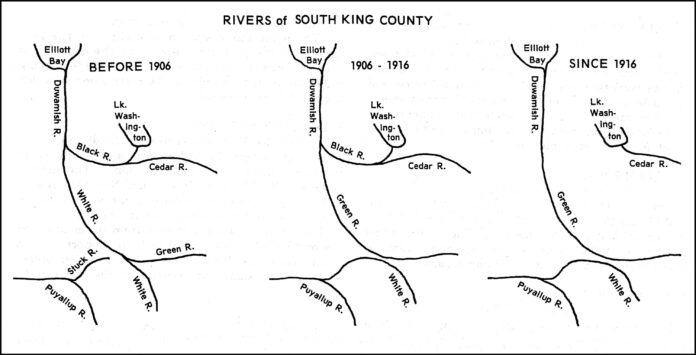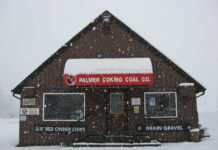The intro to the 1950s Superman television show claimed, “He can change the course of mighty rivers.” So it was with early settlers and the rivers of South King County. This illustration charts three major changes that established the area’s current hydrology. The first alteration came as a result of river wars between farmers in King and Pierce counties. In the era before dams modulated river flows, the Kent Valley was subject to frequent floods by the combined forces of the White and Green Rivers. The floods caused significant damage to the growing settlements of Kent and Auburn, where the two rivers merged. King County residents first diverted the White to flow toward Puyallup, but the Pierce County faction blasted a formidable bluff to move the river’s course back to the north. A massive flood in 1906 again sent the White River into the Stuck River and ultimately the Puyallup. Lawsuits were filed and levees were built, but new channel dredging and a settlement agreement sealed White River’s fate. It would henceforth flow to Tacoma.
The next big change to the course of mighty rivers came in 1912, when the Cedar River was diverted from its confluence with the Black River, to flow directly into Lake Washington. A canal, 6,000 feet in length was dug with over 300,000 cubic yards removed. Renton officials hoped the dredging would create a deep water port and create factory sites on each side of the new channel. The above map is incorrect as to the date of this particular work.
Four years later, the granddaddy of creative engineering was completed. That’s when Lake Washington was lowered nine feet after a channel was cut through Montlake connecting it to Lake Union, Salmon Bay and ultimately Puget Sound by way of two locks in Ballard. Previously, Lake Washington had discharge through the Black River into the Duwamish River near Tukwila. The lowered lake in turn caused the Black River to dry up and in time was erased from maps. The lowered Lake Washington exposed hundreds of acres of previously submerged land, an example of which are the parking lots near Husky Stadium. That area is adjacent to the half-mile long Montlake canal where U.W. crew races are traditionally held on the first Saturday in May to mark the opening of boating season.







